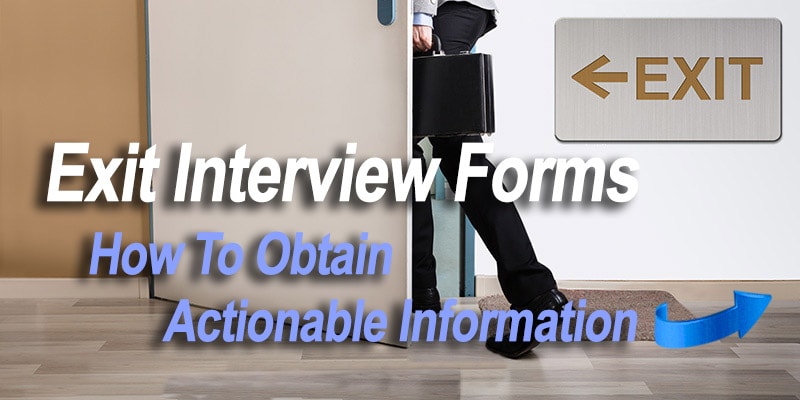Is your businesses guilty of letting important data on employee satisfaction simply walk out the door? Far from being a pointless exercise, exit interviews can provide essential insights into how your company is doing on the employee engagement front, and perhaps more importantly, what it needs to do to improve. So, rather than letting the opportunity disappear along with the departing employee, a formal exit interview process will enable you to capture all that data and information so that you can bring about positive change for your current and future employees. Find out all you need to know about exit interviews in this post. From the reasons why they are important through to possible formats and interview questions, we examine the how, what and why of exit interviews.
What Is An Exit Interview?
A wrap-up meeting between the employer and the departing employee, the exit interview provides the opportunity to gather frank and honest feedback about your organization. You can dig deeper into the reasons why the employee is leaving and gain valuable insights that will guide future working practices.
Attracting and retaining the best talent available in the market is becoming an increasing challenge for every business. The candid opinions of departing employees, when used wisely, can help in the quest to improve your recruitment processes and increase employee retention rates.

If key staff members are leaving in their droves, then it’s essential that you understand the real reasons as to why rather than guessing what those may be. Otherwise, how can you know what areas you need to improve?
It’s important to remember though that the exit interview doesn’t have to be a negative experience where the soon-to-be former employee simply moans and groans about all the things that are wrong in your company. Rarely are things as black and white as that. A well-conducted exit interview will encompass both positive and negative feedback for a more rounded view of where you’re at as an employer.
The Benefits Of Conducting An Exit Interview
It’s a fact that a departing employee will provide more honest feedback than any current one because unlike existing staff members, they have nothing to lose. And while it may be too late to resolve any grumbles or gripes for the former employee, the feedback they provide can be used in a positive way to improve practices for current and future employees.
Businesses have structured their exit interviews to cover a wide range of work-related issues including:
 company culture, mission and values
company culture, mission and values- workplace environment
- tools of the trade
- internal communications
- relationships with colleagues and managers
- support for professional development and career advancement
- level of employee satisfaction and staff morale.
The information harvested from the exit interview process can be used to improve a range of workplace practices including:
- processes for recruiting and hiring new team members
- more effective job descriptions
- employee retention initiatives
- improvements to workplace design and the office environment
- changes to company culture or team morale.
So, although exit interviews may at first appear to be a pointless, after-the-horse-has-bolted initiative, the truth is that they have an essential part to play in ensuring a healthy and responsive management structure for every business.
How To Conduct An Effective Exit Interview
Now that we have a common understanding of the what and why, let’s turn our attention to the how. How do you conduct an effective exit interview? What are the critical elements needed for a successful outcome? Well, the starting point is the interview format.
Select Your Exit Interview Format
The first point to make is that participation in an exit interview must be entirely voluntary. It sets the wrong tone if staff members are coerced and forced in attendance and you simply won’t achieve your aims and objectives.
 Some businesses prefer to conduct exit interviews via a questionnaire. This may be a good choice if you have a small HR department or you are anticipating an uncomfortable discussion. Other options include a phone interview or email survey.
Some businesses prefer to conduct exit interviews via a questionnaire. This may be a good choice if you have a small HR department or you are anticipating an uncomfortable discussion. Other options include a phone interview or email survey.
The best format, however, is the face-to-face interview. It allows you to dig deeper into issues in a way that isn’t possible with a questionnaire. For example, if the departing employee tells you that one of the reasons they are leaving is because of a lack of opportunities for career advancement. Instead of a simple yes/no tick box, a personal interview allows you to explore the issue in more depth.
Face-to-face exit interviews also send an important message to other staff members that you value your employees’ opinions and take the time to listen. This will also give your all-round rates of employee engagement a healthy boost.
Choose The Interviewer
If you want to encourage a full and frank discussion, then it’s best to have a neutral, unbiased person such as an HR representative to conduct the interview. After all, the employee that is leaving because of their manager is unlikely to say so if that manager is conducting the interview.
Select The Venue
 Similarly, a neutral venue rather than the manager’s office will be more conducive to constructive discussion. You may even want to consider taking the meeting off-site altogether to a local coffee shop for example.
Similarly, a neutral venue rather than the manager’s office will be more conducive to constructive discussion. You may even want to consider taking the meeting off-site altogether to a local coffee shop for example.
Setting The Scene
Start the interview by making it clear to the employee that there will be no negative consequences as a result of the feedback they provide. This is essential to putting the staff member at ease and comfortable about speaking their mind.
In addition, explain that the feedback gathered from exit interviews is aggregated so that the company can identify any underlying trends and issues. It’s also used to help the organization improve on its practices so that more valued employees are retained.
Sample Exit Interview Questions
This is the heart of the interview. Don’t ask so many questions that the meeting goes on for hours, leaving both participants exhausted. Instead, try and focus on the following four key areas to elicit the most useful feedback:
- reasons for leaving
- personal relationships with managers and peers
- tools of the trade and workplace environment
- company culture.
It is quick and easy to develop your own exit interview template using the company intranet’s in-built forms builder or an intranet-embedded Google Form. Alternatively, here is a downloadable checklist of sample exit interview questions that you can use or adapt to suit your own requirements. Use the questions below to guide the discussions in the exit interview. There’s no need to stick to them rigidly – sometimes the conversation will take you off in unexpected directions and so it’s important to be flexible.
Here are the list of questions available as a Word document or PDF file: Exit-Interview-Sample-Questions.docx / Exit-Interview-Sample-Questions.pdf
|
Exit Interview Sample Questions |
|
| Questions On Reasons For Leaving | Responses |
| 1. Why have you decided to leave?
2. What prompted you to start looking for a new job in the first place? 3. Did you at any stage share your concerns with a colleague or manager? How did they respond? |
|
| Questions On Relationships With Managers & Colleagues | Responses |
| 4. How was your relationship with your immediate manager?
5. What could your manager do to improve their management style? 6. Did your manager set clear goals and targets in your role? 7. Did you receive feedback on your day-to-day performance in the role? 8. On a scale of 1 to 10 with ten being the highest how would you rate morale in your team? |
|
| Questions On Tools Of The Trade & Workplace Environment | Responses |
| 9. What did you like most about your job?
10. What did you dislike the most? 11. What would you change about your job? 12. Did you have the necessary resources, training and support to get the job done? 13. Did the job description adequately reflect the requirements of the position? 14. What improvements would you suggest to help us develop a better workplace? 15. Do you have any recommendations on the company’s recognition and reward schemes or employee benefits package? 16. What would make you consider working for the company again at some point in the future? |
|
| Questions On Company Culture | Responses |
| 17. Would you recommend the company to others as being a good place to work?
18. Did you feel as though you understood the company’s goals and your contribution towards their achievement? 19. What are your views on the company’s management and leadership style as a whole? 20. Is there anything else you would like to discuss about your reasons for leaving and how the company could improve? |
|
Exit Interview Questions Not To Ask
It’s essential to keep things as positive and upbeat as possible. While it’s important to hear any negative feedback, too much emphasis on bad experiences and grievances is likely to be draining to both participants and can be counter-productive.
In addition, there’s no point in asking the departing employee if they are willing to reconsider their decision. It’s too late for that and the exit interview isn’t the forum for those sorts of discussions.
Furthermore, try and avoid getting into detailed discussions about individual managers or co-workers. The former employee may well have some genuine grievances to air, however, keeping things on a professional level is essential. Don’t let things get too personal and so avoid questions that might be targeted at specific issues or people.
Exit Interviews: Actionable Feedback
Exit interviews will provide a wealth of insights and actionable data that you can use to progress the organization: from improving the hiring process, refining job descriptions, through to enhancements to workplace design, internal communications or company culture.
Feedback from exit interviews should be aggregated and anonymized. Trends and issues should be reported to management on a regular basis, preferably quarterly, and action taken to address concerns where appropriate. Sometimes it’s an easy fix such as gripes about the air-con temperature being too high or low or complaints around poor kitchen facilities. Other times the issues will be more difficult to resolve with concerns voiced around leadership and management or aspects of the company culture. However, senior managers need to be aware of all the feedback – both positive and negative – so that they can set about continuously improving the company.
 And when it comes to feedback, don’t forget to report back, via the intranet’s news feed, to the wider staff body on any key issues. One of the main drivers of employee engagement is valuing staff. Being seen to take the time to listen, respond to and act on the views of staff members – even if they are departing ones – will enhance levels of employee engagement and satisfaction generally. Research consistently tells us that employees who are engaged are more invested in the company, are more productive and are less likely to be sick or absent. And they are also more likely to stay longer in their jobs. So, investing in employee engagement initiatives, including conducting exit interviews, is well worth the effort.
And when it comes to feedback, don’t forget to report back, via the intranet’s news feed, to the wider staff body on any key issues. One of the main drivers of employee engagement is valuing staff. Being seen to take the time to listen, respond to and act on the views of staff members – even if they are departing ones – will enhance levels of employee engagement and satisfaction generally. Research consistently tells us that employees who are engaged are more invested in the company, are more productive and are less likely to be sick or absent. And they are also more likely to stay longer in their jobs. So, investing in employee engagement initiatives, including conducting exit interviews, is well worth the effort.
Exit Interviews: Integral To Effective Management
The bottom line is that the exit interview is integral to effective management practices and organizational development. It’s an easily implemented tool to gather important data on what your company is doing well and what it needs to do to improve. Don’t be one of those businesses that simply lets key data walk out the door. Set up an exit interview process to capture that useful feedback before it disappears for good.
Are you interested in finding out more about exit interviews and, in particular, how an office intranet could support the process, then get in touch with us here at MyHub. Our super-easy to install and use intranet software will support this and many other business processes for a more efficient and productive workplace. You don’t need to be an expert in IT either! Simple to understand and follow setup processes together with our help and support means that you can have your intranet up and running in just a few hours. Get in touch today for a free demo or a no-obligation 14-day trial.








0 Comments